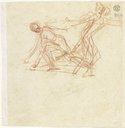Back to top
- Born
- 1594 in Villers-en-Vexin
- Died
- 1665 in Rome
- School
- Baroque
20 Works by Nicolas Poussin
- Landscape during a Thunderstorm with Pyramus and Thisbe
![Landscape during a Thunderstorm with Pyramus and Thisbe, Nicolas Poussin]()
- Anbetung des goldenen Kalbes
![Anbetung des goldenen Kalbes, Nicolas Poussin; ?]()
- Children Playing Leapfrog
![Children Playing Leapfrog, Nicolas Poussin; ?]()
- Clio and Pheme
![Clio and Pheme, Nicolas Poussin]()
- Die Heilige Familie mit der Heiligen Elisabeth und dem Johannesknaben in einer Landschaft
![Die Heilige Familie mit der Heiligen Elisabeth und dem Johannesknaben in einer Landschaft, Nicolas Poussin; ?]()
- Ein Soldat unterstützt einen Sterbenden
![Ein Soldat unterstützt einen Sterbenden, Nicolas Poussin; ?, after Raphael, after Giulio Romano]()
- God the Father appears to Noah
![God the Father appears to Noah, Nicolas Poussin; ?]()
- Hippomenes and Atalanta
![Hippomenes and Atalanta, Nicolas Poussin; ?]()
- Kniender Johannesknabe mit dem auf dem Kreuz schlafenden Christuskind
![Kniender Johannesknabe mit dem auf dem Kreuz schlafenden Christuskind, Nicolas Poussin; circle]()
- Kniender Johannesknabe mit Lamm und dem auf dem Kreuz schlafenden Christuskind
![Kniender Johannesknabe mit Lamm und dem auf dem Kreuz schlafenden Christuskind, Nicolas Poussin; circle]()
- Narziß betrachtet sich in der Quelle
![Narziß betrachtet sich in der Quelle, Nicolas Poussin; ?]()
- Römische Matrone am Sterbebett ihres Mannes
![Römische Matrone am Sterbebett ihres Mannes, Nicolas Poussin; ?]()
- Sacrifice of Iphigenia
![Sacrifice of Iphigenia, Nicolas Poussin; ?]()
- Studie nach Raffaels "Vertreibung Heliodors aus dem Tempel" sowie weibliche Figuren
![Studie nach Raffaels "Vertreibung Heliodors aus dem Tempel" sowie weibliche Figuren, Nicolas Poussin; ?, after Raphael]()
- The death of Germanicus
![The death of Germanicus, Nicolas Poussin; circle]()
- The death of Socrates
![The death of Socrates, Nicolas Poussin; circle]()
- The death of Socrates
![The death of Socrates, Nicolas Poussin; circle]()
- The widow's penny
![The widow's penny, Nicolas Poussin; ?]()
- Waldlandschaft an einem Teich
![Waldlandschaft an einem Teich, style of Nicolas Poussin]()
- Zwei Figuren aus dem Raub der Sabinerinnen
![Zwei Figuren aus dem Raub der Sabinerinnen, Nicolas Poussin; ?]()
3 Works based on Nicolas Poussin
- Johann Anton Ramboux, after Nicolas Poussin, after Francesco PrimaticcioDas Gleichnis von den Arbeitern im Weinberg, Primaticcios Garten des Vertumnus und Poussins Reich der Flora nachempfunden
![Das Gleichnis von den Arbeitern im Weinberg, Primaticcios Garten des Vertumnus und Poussins Reich der Flora nachempfunden, Johann Anton Ramboux, after Nicolas Poussin, after Francesco Primaticcio]()
- Jan Punt, after Nicolas PoussinHeilige Familie, Maria lehrt das Kind lesen
![Heilige Familie, Maria lehrt das Kind lesen, Jan Punt, after Nicolas Poussin]()
- François Chauveau; ?, after Nicolas PoussinJagd von Meleager und Atalante
![Jagd von Meleager und Atalante, François Chauveau; ?, after Nicolas Poussin]()
Works displaying Nicolas Poussin
Biography
Persons connected to Nicolas Poussin
- Bartoli, Pietro Santi Pupil (male)
- Bouzonnet Stella, Antoine Pupil (male)
- Dughet, Gaspard Pupil (male)
- Dal Pozzo, Cassiano Sponsor (male)
- Duquesnoy, François Friend (male)
- Errard the Younger, Charles Friend (male)
- Lorrain, Claude Friend (male)
- Sacchi, Andrea Friend (male)
- Testa, Pietro Friend (male)
- Vuibert, Remy Friend (male)
Works associated with Nicolas Poussin
- Johann Franciscus ErmelsLandscape before a Thunderstorm
![Landscape before a Thunderstorm, Johann Franciscus Ermels]()
- Jan van GoyenPath through the Dunes
![Path through the Dunes, Jan van Goyen]()
- Johann Franciscus ErmelsRocky Landscape in the Evening Light
![Rocky Landscape in the Evening Light, Johann Franciscus Ermels]()
- Paul CézanneAvenue of Chestnut Trees at the Jas de Bouffan
![Avenue of Chestnut Trees at the Jas de Bouffan, Paul Cézanne]()
- Louis-Léopold BoillyThe Folly of the Day
![The Folly of the Day, Louis-Léopold Boilly]()
- Constant BourgeoisThe Great Gallery in the Louvre
![The Great Gallery in the Louvre, Constant Bourgeois]()





























